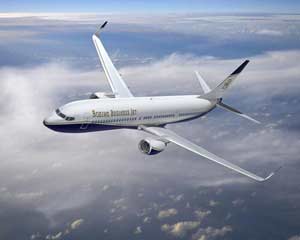First VVIP Boeing aircraft arrives in India, government to sign end user agreement with US
05 August 2008
New Delhi: The first of three wide-bodied Boeing Business Jets (BBJs), ordered by the Government of India in October 2005 for the Indian Air Force's VVIP squadron landed at the capital's Palam airport over the weekend. Ordered at a cost of Rs937 crore, the three aircraft will join the IAF's elite communication squadron, which ferries national dignitaries such as the president and the PM.
According to ministry of defence (MoD) officials, the other two aircraft are also expected to follow the first one into Palam over the next 45 days.
 The BBJs are highly customised aircraft that come equipped with sophisticated self-protection suites (SPS), encrypted satellite communication facilities and advanced navigation aids. These features are similar to those installed onboard the United States Air Force 1, used by the American president.
The BBJs are highly customised aircraft that come equipped with sophisticated self-protection suites (SPS), encrypted satellite communication facilities and advanced navigation aids. These features are similar to those installed onboard the United States Air Force 1, used by the American president.
Interestingly, delivery of these aircraft, was delayed by at least six months due to Washington's insistence on proper safeguards for all the restricted-access security equipment, such as the SPS , installed on the aircraft. India has now agreed to let US Air Force officials inspect the aircraft to ensure that there has been no tinkering with the sensitive technology deployed onboard.
Pentagon delayed delivery lacking any end user verification agreement with India. It has concerns that since the technology used in the US president's aircraft is also similar to that deployed on the Indian versions there has to be an agreement that will ensure secrecy of these technologies as any leakage or tinkering could also impact the security of the American president.
India is now due to sign the End-Use Verification Agreement (EUVA) and the Communication Interoperability and Security Memorandum of Agreement (CISMOA) with the US. Under US laws, a country accessing American defence equipment must negotiate these agreements in order to minimise security risks to the US and its allies and also to ensure compliance with sensitive technology control requirements.
